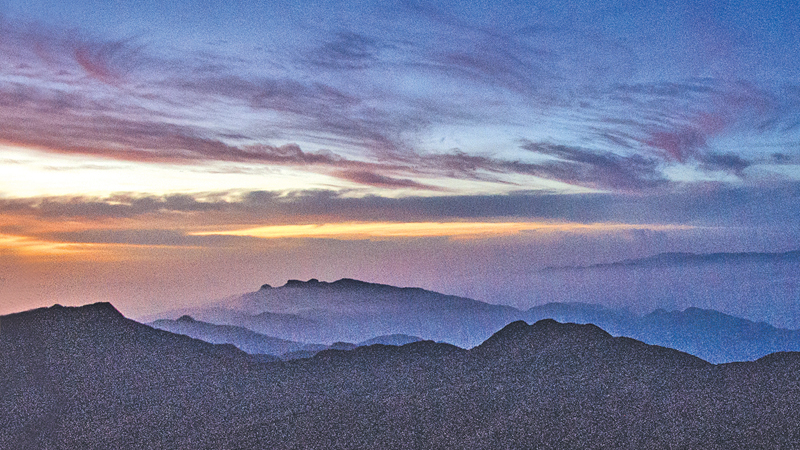 The western lower ridges of the central hills form an arduously rocky cone, which rises higher than the rest of the surroundings. Sri Pada at a staggering 2,238 metres (7,360-feet) above sea level, is the fourth tallest mountain in Sri Lanka. Sri Pada is part of the main water-shed of Sri Lanka, from which her four largest rivers spring. Trekked by millions of pilgrims and visitors every year, the holy mountain Sri Pada, commands a striking position in Sri Lanka’s rich physical geography and culture and is perhaps one of the best-documented mountains in South Asia.
The western lower ridges of the central hills form an arduously rocky cone, which rises higher than the rest of the surroundings. Sri Pada at a staggering 2,238 metres (7,360-feet) above sea level, is the fourth tallest mountain in Sri Lanka. Sri Pada is part of the main water-shed of Sri Lanka, from which her four largest rivers spring. Trekked by millions of pilgrims and visitors every year, the holy mountain Sri Pada, commands a striking position in Sri Lanka’s rich physical geography and culture and is perhaps one of the best-documented mountains in South Asia.
The mountain is also seen as the abode of the deity Sumana Saman. In its early records the pyramid-shaped peak is referred to as Samanalakanda (the mountain of butterflies). Before the arrival of Buddhism in the island, the deity Saman was regarded supreme. Buddhists refer to it as ‘Sri Pada,’referring to the sacred or resplendent impression of a footprint of the Buddha, which crowns a large granite boulder on the summit. The ‘Peak of Adam’ was the name given to it by early Muslim traders and it was well documented by medieval travellers such as Ibn Battuta and Marco Polo. In colonial times, this was simplified to Adam’s Peak.
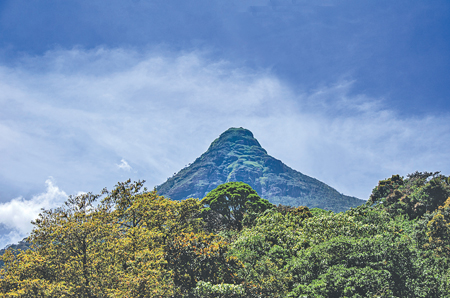
The Sri Pada peak as seen from Seethagangula near Nallathanniya
My first ascent to the summit of Sri Pada as a seven-year-old ‘Kiri Kodu’ (first-time child climber) was in 1972 with my grandmother on a pilgrimage to the sacred peak. Thereafter, we (the writer) climbed Sri Pada three times in recent years carrying cameras to capture the ecology, landscape, people and panoramic views from the peak.
Difficult climb
The pilgrimage covers many aspects of the climb and the rituals associated with it. As everyone knows, the climb is a difficult one. Pilgrims witness human endurance on the climb. Pilgrims are exhausted climbing the trails of Sri Pada. Mahagiridamba, which is one of the steepest sections of the climb and is the final test of endurance for pilgrims. At the summit, one can see the tired faces of pilgrims but are filled with devotion. We see devotees worshipping while on the trek, even before reaching the summit. On the way to the summit, youngsters extend a helping hand to the seniors as they trudge on wearily. The unique biodiversity of the sacred mountain has been identified as a UNESCO World Heritage site in 2010.
The rituals of the Sri Pada season begin just before midnight on Unduvap Poya day in December. Pilgrims clad in pure white move in processions bearing the image of the deity Sumana Saman and relics from the Galpothtawala Rajamaha Vihara in Pelmadulla. The processions converge at Nallathanniya, Erathna and Palabaddala and then proceed past Seethagangula, Indikatu Pahana and finally Mahagiridamba to reach the summit. Every offering and chant signifies purity and reverence to the deity of the Samanala Adaviya: God Suman Saman. The Sri Pada pilgrimage season begins in December and continues until the Wesak festival in May.
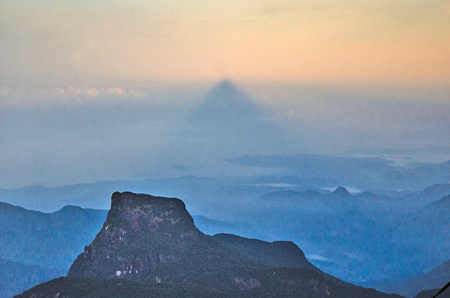
The pyramid shadow of the Sri Pada Mountain cast in the western slopes
Ratnapura is the ‘classical’ gateway for the climb up of 7,360 feet (2,243-metres)to Adam’s Peak. It is 8.5 kilometres on foot to the top of the pointed peak on this arduous route through Palabaddala. The other route, from Maskeliya via Nallathanniya begins at a much higher elevation and is a much easier ascent of five kilometres. Other routes are from Kuruwita-Erathna and Deraniyagala-Maliboda and are favoured due to the convenience in reaching the starting point.
Sacred to all religions
All four major religions in Sri Lanka claim Adam’s Peak as a holy mountain. Buddhists call the mountain Sri Pada (‘the sacred footprint’) and say it was visited by Gautama Buddha himself. The Hindus call the peak Shivan Adipatha and say Lord Shiva’s footprint is preserved. Muslims insist it is the place where Adam first set foot on earth. And many Roman Catholics say according to tradition, the footprint impressed on the boulder at the summit is that of St. Thomas, the early Christian apostle who preached in South India. At least, since the 11th century, the mountain has been a goal of pilgrims. King Vijayabahu I and King Nissanka Malla of Polonnaruwa both recorded their pilgrimages here. The Mahavamsa made reference to the Buddha’s footprint atop the mountain.
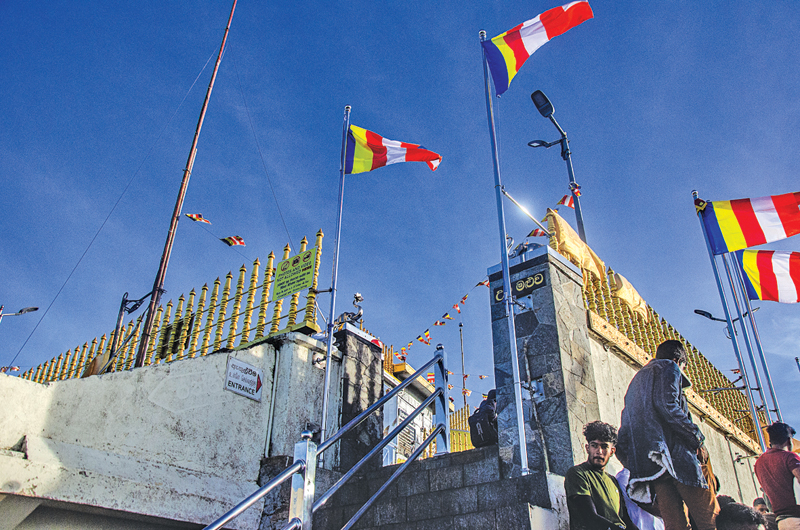
‘Uda maluwa’ – this building at the pinnacle houses the sacred footprint
Most of the pilgrims who make the journey climb at night up a staircase illuminated by electric lamps. Frequent ambalamas (pilgrim rests) and refreshment stalls make the climb easier. At the summit or ‘Uda maluwa’ temple, gives way to the continuous chanting of ‘pirith’ of the resident bhikkhus as they emerge bearing lotus flowers and incense – offerings to the Temple of the Footprint. The assembled pilgrims bend towards the shrine, foreheads on the flower-laden footprint. We have seen people pushed to the brink of exhaustion by the marathon climb; devotees who stand in the freezing cold at the peak waiting to catch a glimpse of the ‘Ira Sewaya’ (sunrise) in the morning and also the sacred mountain’s breathtaking beauty.
Vibrant colours
Those who reach the summit by dawn are eager to witness the spectacular ‘Ira sewaya’ where the sun fluctuates for a few minutes before it rises. The entire eastern horizon illuminates with vibrant colours. At the same time, one can see the pyramid shadow appear as the sun lines up behind Adam’s Peak. It floats beneath. The triangle is perfect. Its colour deepens, quickly fades and is gone!
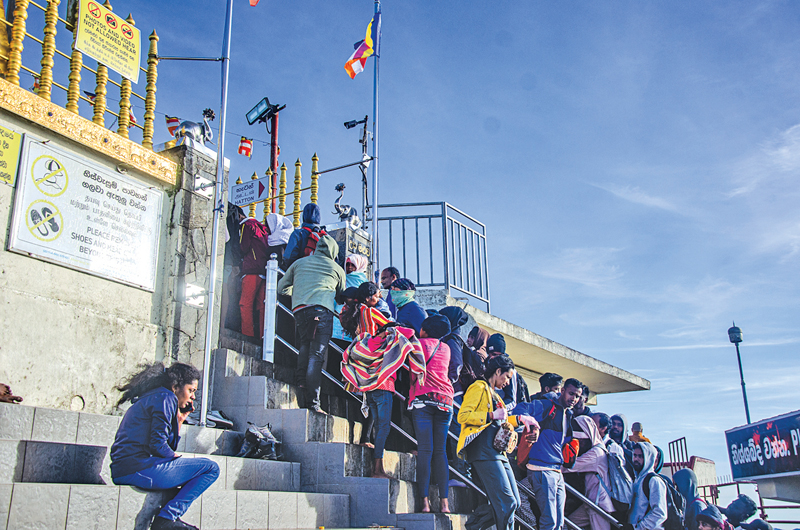
Pilgrims take turns to worship at the sacred footprint
These pilgrims follow a number of unique traditions in their ascent. It is customary for first-time climbers to pile great turbans of white cloth on their heads. At Seethagangula, one may seek to refresh oneself in the cool waters that gush across. On both main routes, the Indikatupana ‘place of the needle’ demands the devout to stop and fling a threaded needle into a shrub by the side of the path, making a spot where the Buddha is said to have paused to mend a tear in his robe. At the summit, a bell clangs incessantly and is reverentially rung by the old and the toddler alike to signify that the pilgrimage is completed. It is said that it is not good to inquire how it is to the top. Instead, pilgrims just exchange the greeting karunavai – ‘peace’.
However, environmental pollution takes its toll and is widely highlighted during the Sri Pada season. Despite efforts to educate pilgrims about proper waste disposal, many fail to adhere to instructions, particularly regarding the disposal of raw food items and plastic bottles. Workers collected tons of plastic bottles discarded by pilgrims visiting the sacred site during the past season. The authorities, however, have installed garbage bins along the pilgrimage route.







